Xiaofan Wang
Label-efficient Single Photon Images Classification via Active Learning
May 07, 2025Abstract:Single-photon LiDAR achieves high-precision 3D imaging in extreme environments through quantum-level photon detection technology. Current research primarily focuses on reconstructing 3D scenes from sparse photon events, whereas the semantic interpretation of single-photon images remains underexplored, due to high annotation costs and inefficient labeling strategies. This paper presents the first active learning framework for single-photon image classification. The core contribution is an imaging condition-aware sampling strategy that integrates synthetic augmentation to model variability across imaging conditions. By identifying samples where the model is both uncertain and sensitive to these conditions, the proposed method selectively annotates only the most informative examples. Experiments on both synthetic and real-world datasets show that our approach outperforms all baselines and achieves high classification accuracy with significantly fewer labeled samples. Specifically, our approach achieves 97% accuracy on synthetic single-photon data using only 1.5% labeled samples. On real-world data, we maintain 90.63% accuracy with just 8% labeled samples, which is 4.51% higher than the best-performing baseline. This illustrates that active learning enables the same level of classification performance on single-photon images as on classical images, opening doors to large-scale integration of single-photon data in real-world applications.
CogACT: A Foundational Vision-Language-Action Model for Synergizing Cognition and Action in Robotic Manipulation
Nov 29, 2024



Abstract:The advancement of large Vision-Language-Action (VLA) models has significantly improved robotic manipulation in terms of language-guided task execution and generalization to unseen scenarios. While existing VLAs adapted from pretrained large Vision-Language-Models (VLM) have demonstrated promising generalizability, their task performance is still unsatisfactory as indicated by the low tasks success rates in different environments. In this paper, we present a new advanced VLA architecture derived from VLM. Unlike previous works that directly repurpose VLM for action prediction by simple action quantization, we propose a omponentized VLA architecture that has a specialized action module conditioned on VLM output. We systematically study the design of the action module and demonstrates the strong performance enhancement with diffusion action transformers for action sequence modeling, as well as their favorable scaling behaviors. We also conduct comprehensive experiments and ablation studies to evaluate the efficacy of our models with varied designs. The evaluation on 5 robot embodiments in simulation and real work shows that our model not only significantly surpasses existing VLAs in task performance and but also exhibits remarkable adaptation to new robots and generalization to unseen objects and backgrounds. It exceeds the average success rates of OpenVLA which has similar model size (7B) with ours by over 35% in simulated evaluation and 55% in real robot experiments. It also outperforms the large RT-2-X model (55B) by 18% absolute success rates in simulation. Code and models can be found on our project page (https://cogact.github.io/).
DiffRoad: Realistic and Diverse Road Scenario Generation for Autonomous Vehicle Testing
Nov 14, 2024



Abstract:Generating realistic and diverse road scenarios is essential for autonomous vehicle testing and validation. Nevertheless, owing to the complexity and variability of real-world road environments, creating authentic and varied scenarios for intelligent driving testing is challenging. In this paper, we propose DiffRoad, a novel diffusion model designed to produce controllable and high-fidelity 3D road scenarios. DiffRoad leverages the generative capabilities of diffusion models to synthesize road layouts from white noise through an inverse denoising process, preserving real-world spatial features. To enhance the quality of generated scenarios, we design the Road-UNet architecture, optimizing the balance between backbone and skip connections for high-realism scenario generation. Furthermore, we introduce a road scenario evaluation module that screens adequate and reasonable scenarios for intelligent driving testing using two critical metrics: road continuity and road reasonableness. Experimental results on multiple real-world datasets demonstrate DiffRoad's ability to generate realistic and smooth road structures while maintaining the original distribution. Additionally, the generated scenarios can be fully automated into the OpenDRIVE format, facilitating generalized autonomous vehicle simulation testing. DiffRoad provides a rich and diverse scenario library for large-scale autonomous vehicle testing and offers valuable insights for future infrastructure designs that are better suited for autonomous vehicles.
Mirror contrastive loss based sliding window transformer for subject-independent motor imagery based EEG signal recognition
Aug 29, 2024



Abstract:While deep learning models have been extensively utilized in motor imagery based EEG signal recognition, they often operate as black boxes. Motivated by neurological findings indicating that the mental imagery of left or right-hand movement induces event-related desynchronization (ERD) in the contralateral sensorimotor area of the brain, we propose a Mirror Contrastive Loss based Sliding Window Transformer (MCL-SWT) to enhance subject-independent motor imagery-based EEG signal recognition. Specifically, our proposed mirror contrastive loss enhances sensitivity to the spatial location of ERD by contrasting the original EEG signals with their mirror counterparts-mirror EEG signals generated by interchanging the channels of the left and right hemispheres of the EEG signals. Moreover, we introduce a temporal sliding window transformer that computes self-attention scores from high temporal resolution features, thereby improving model performance with manageable computational complexity. We evaluate the performance of MCL-SWT on subject-independent motor imagery EEG signal recognition tasks, and our experimental results demonstrate that MCL-SWT achieved accuracies of 66.48% and 75.62%, surpassing the state-of-the-art (SOTA) model by 2.82% and 2.17%, respectively. Furthermore, ablation experiments confirm the effectiveness of the proposed mirror contrastive loss. A code demo of MCL-SWT is available at https://github.com/roniusLuo/MCL_SWT.
Structured Deep Neural Networks-Based Backstepping Trajectory Tracking Control for Lagrangian Systems
Mar 01, 2024Abstract:Deep neural networks (DNN) are increasingly being used to learn controllers due to their excellent approximation capabilities. However, their black-box nature poses significant challenges to closed-loop stability guarantees and performance analysis. In this paper, we introduce a structured DNN-based controller for the trajectory tracking control of Lagrangian systems using backing techniques. By properly designing neural network structures, the proposed controller can ensure closed-loop stability for any compatible neural network parameters. In addition, improved control performance can be achieved by further optimizing neural network parameters. Besides, we provide explicit upper bounds on tracking errors in terms of controller parameters, which allows us to achieve the desired tracking performance by properly selecting the controller parameters. Furthermore, when system models are unknown, we propose an improved Lagrangian neural network (LNN) structure to learn the system dynamics and design the controller. We show that in the presence of model approximation errors and external disturbances, the closed-loop stability and tracking control performance can still be guaranteed. The effectiveness of the proposed approach is demonstrated through simulations.
Learning Bifunctional Push-grasping Synergistic Strategy for Goal-agnostic and Goal-oriented Tasks
Dec 04, 2022



Abstract:Both goal-agnostic and goal-oriented tasks have practical value for robotic grasping: goal-agnostic tasks target all objects in the workspace, while goal-oriented tasks aim at grasping pre-assigned goal objects. However, most current grasping methods are only better at coping with one task. In this work, we propose a bifunctional push-grasping synergistic strategy for goal-agnostic and goal-oriented grasping tasks. Our method integrates pushing along with grasping to pick up all objects or pre-assigned goal objects with high action efficiency depending on the task requirement. We introduce a bifunctional network, which takes in visual observations and outputs dense pixel-wise maps of Q values for pushing and grasping primitive actions, to increase the available samples in the action space. Then we propose a hierarchical reinforcement learning framework to coordinate the two tasks by considering the goal-agnostic task as a combination of multiple goal-oriented tasks. To reduce the training difficulty of the hierarchical framework, we design a two-stage training method to train the two types of tasks separately. We perform pre-training of the model in simulation, and then transfer the learned model to the real world without any additional real-world fine-tuning. Experimental results show that the proposed approach outperforms existing methods in task completion rate and grasp success rate with less motion number. Supplementary material is available at https: //github.com/DafaRen/Learning_Bifunctional_Push-grasping_Synergistic_Strategy_for_Goal-agnostic_and_Goal-oriented_Tasks
Autoregressive GNN-ODE GRU Model for Network Dynamics
Nov 19, 2022Abstract:Revealing the continuous dynamics on the networks is essential for understanding, predicting, and even controlling complex systems, but it is hard to learn and model the continuous network dynamics because of complex and unknown governing equations, high dimensions of complex systems, and unsatisfactory observations. Moreover, in real cases, observed time-series data are usually non-uniform and sparse, which also causes serious challenges. In this paper, we propose an Autoregressive GNN-ODE GRU Model (AGOG) to learn and capture the continuous network dynamics and realize predictions of node states at an arbitrary time in a data-driven manner. The GNN module is used to model complicated and nonlinear network dynamics. The hidden state of node states is specified by the ODE system, and the augmented ODE system is utilized to map the GNN into the continuous time domain. The hidden state is updated through GRUCell by observations. As prior knowledge, the true observations at the same timestamp are combined with the hidden states for the next prediction. We use the autoregressive model to make a one-step ahead prediction based on observation history. The prediction is achieved by solving an initial-value problem for ODE. To verify the performance of our model, we visualize the learned dynamics and test them in three tasks: interpolation reconstruction, extrapolation prediction, and regular sequences prediction. The results demonstrate that our model can capture the continuous dynamic process of complex systems accurately and make precise predictions of node states with minimal error. Our model can consistently outperform other baselines or achieve comparable performance.
Autonomous Highway Merging in Mixed Traffic Using Reinforcement Learning and Motion Predictive Safety Controller
Apr 03, 2022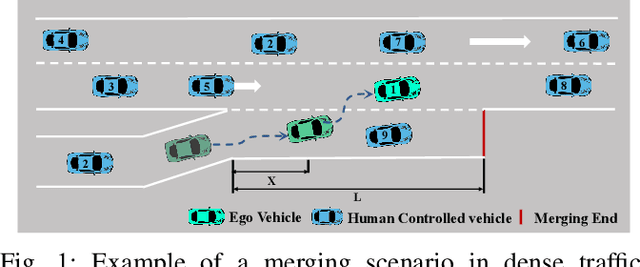
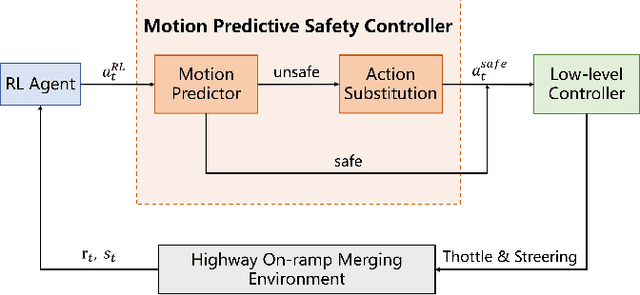
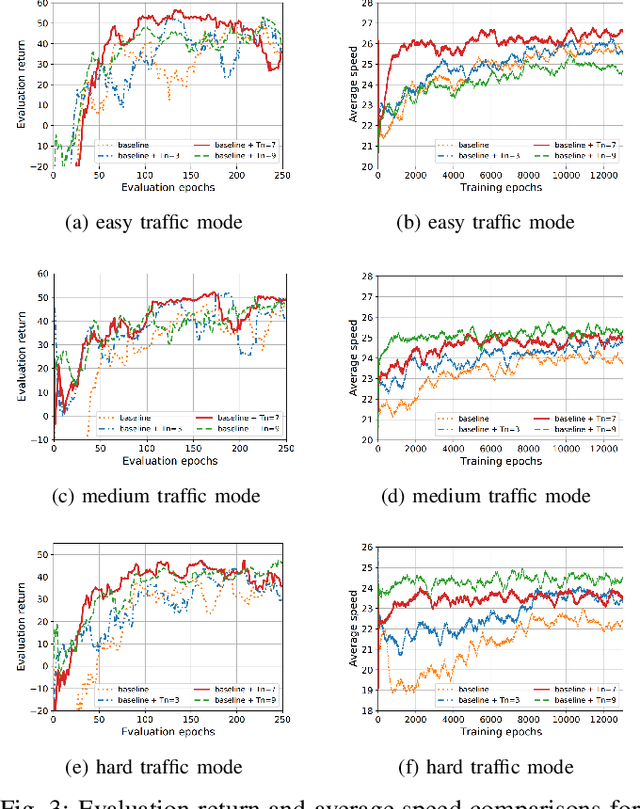
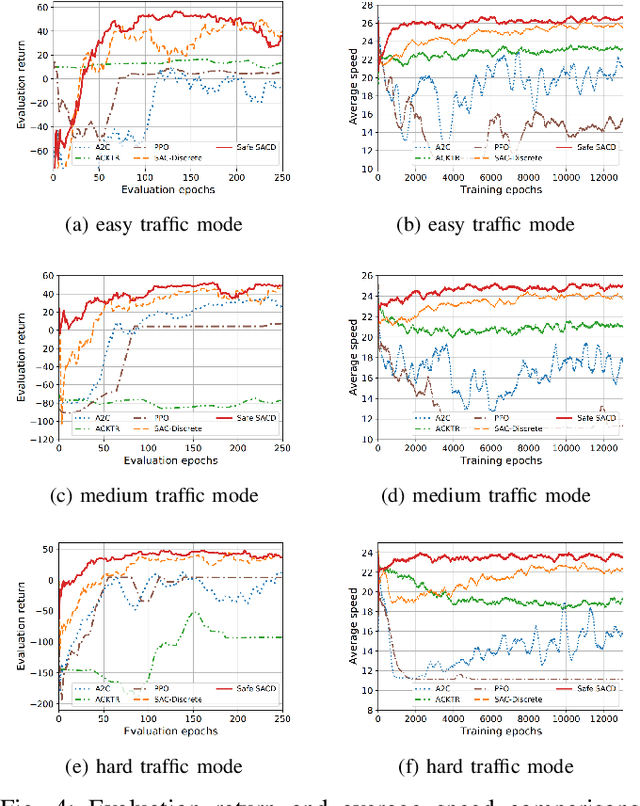
Abstract:Deep reinforcement learning (DRL) has a great potential for solving complex decision-making problems in autonomous driving, especially in mixed-traffic scenarios where autonomous vehicles and human-driven vehicles (HDVs) drive together. Safety is a key during both the learning and deploying reinforcement learning (RL) algorithms process. In this paper, we formulate the on-ramp merging as a Markov Decision Process (MDP) problem and solve it with an off-policy RL algorithm, i.e., Soft Actor-Critic for Discrete Action Settings (SAC-Discrete). In addition, a motion predictive safety controller including a motion predictor and an action substitution module, is proposed to ensure driving safety during both training and testing. The motion predictor estimates the trajectories of the ego vehicle and surrounding vehicles from kinematic models, and predicts potential collisions. The action substitution module updates the actions based on safety distance and replaces risky actions, before sending them to the low-level controller. We train, evaluate and test our approach on a gym-like highway simulation with three different levels of traffic modes. The simulation results show that even in harder traffic densities, our proposed method still significantly reduces collision rate while maintaining high efficiency, outperforming several state-of-the-art baselines in the considered on-ramp merging scenarios. The video demo of the evaluation process can be found at: https://www.youtube.com/watch?v=7FvjbAM4oFw
Investigating and Modeling the Dynamics of Long Ties
Sep 22, 2021



Abstract:Long ties, the social ties that bridge different communities, are widely believed to play crucial roles in spreading novel information in social networks. However, some existing network theories and prediction models indicate that long ties might dissolve quickly or eventually become redundant, thus putting into question the long-term value of long ties. Our empirical analysis of real-world dynamic networks shows that contrary to such reasoning, long ties are more likely to persist than other social ties, and that many of them constantly function as social bridges without being embedded in local networks. Using a novel cost-benefit analysis model combined with machine learning, we show that long ties are highly beneficial, which instinctively motivates people to expend extra effort to maintain them. This partly explains why long ties are more persistent than what has been suggested by many existing theories and models. Overall, our study suggests the need for social interventions that can promote the formation of long ties, such as mixing people with diverse backgrounds.
Fast-Learning Grasping and Pre-Grasping via Clutter Quantization and Q-map Masking
Jul 06, 2021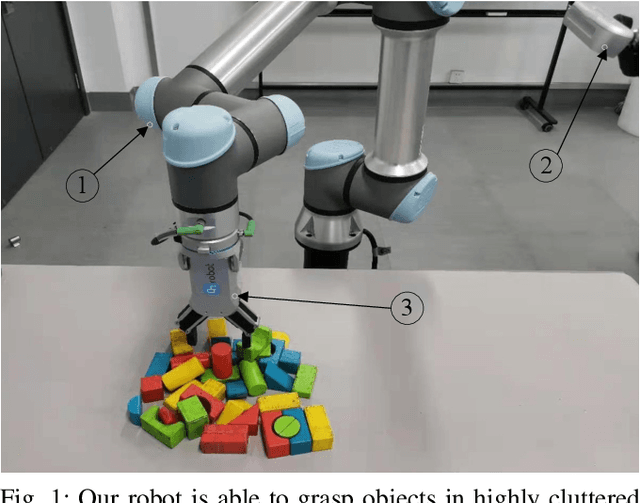
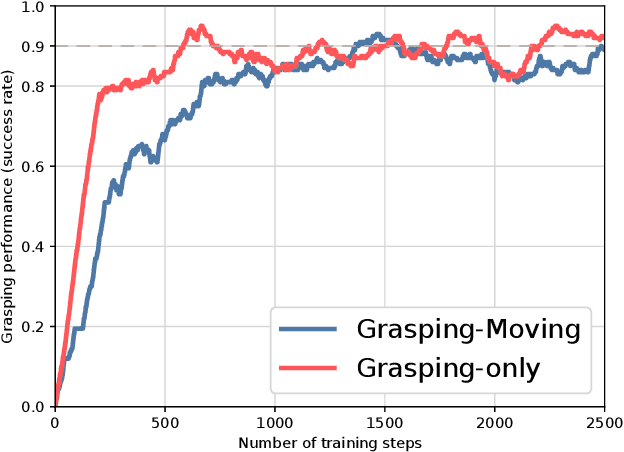
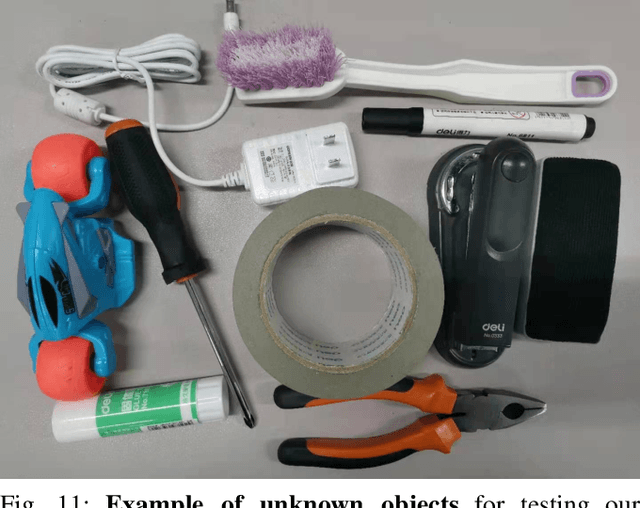
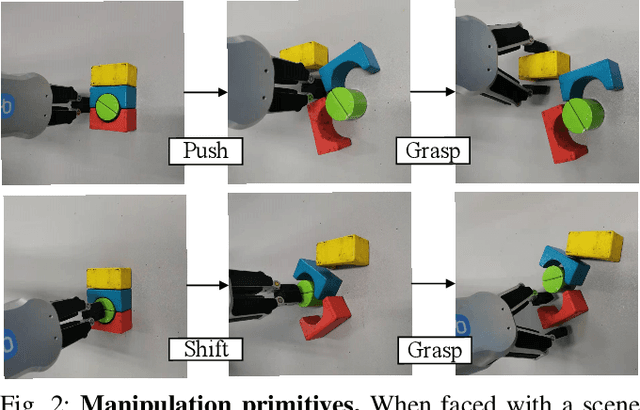
Abstract:Grasping objects in cluttered scenarios is a challenging task in robotics. Performing pre-grasp actions such as pushing and shifting to scatter objects is a way to reduce clutter. Based on deep reinforcement learning, we propose a Fast-Learning Grasping (FLG) framework, that can integrate pre-grasping actions along with grasping to pick up objects from cluttered scenarios with reduced real-world training time. We associate rewards for performing moving actions with the change of environmental clutter and utilize a hybrid triggering method, leading to data-efficient learning and synergy. Then we use the output of an extended fully convolutional network as the value function of each pixel point of the workspace and establish an accurate estimation of the grasp probability for each action. We also introduce a mask function as prior knowledge to enable the agents to focus on the accurate pose adjustment to improve the effectiveness of collecting training data and, hence, to learn efficiently. We carry out pre-training of the FLG over simulated environment, and then the learnt model is transferred to the real world with minimal fine-tuning for further learning during actions. Experimental results demonstrate a 94% grasp success rate and the ability to generalize to novel objects. Compared to state-of-the-art approaches in the literature, the proposed FLG framework can achieve similar or higher grasp success rate with lesser amount of training in the real world. Supplementary video is available at https://youtu.be/e04uDLsxfDg.
 Add to Chrome
Add to Chrome Add to Firefox
Add to Firefox Add to Edge
Add to Edge